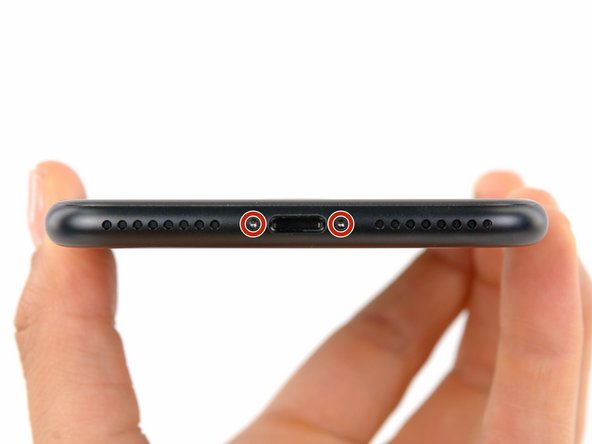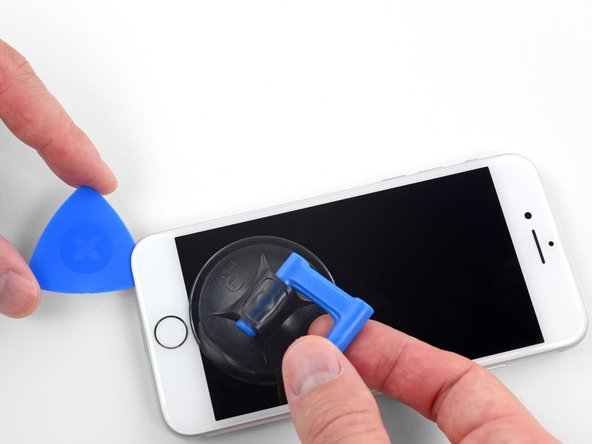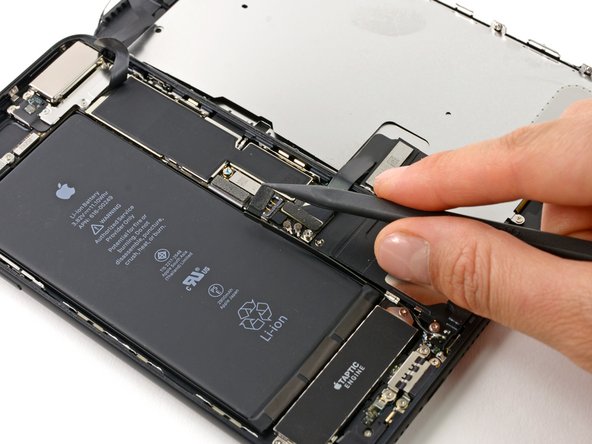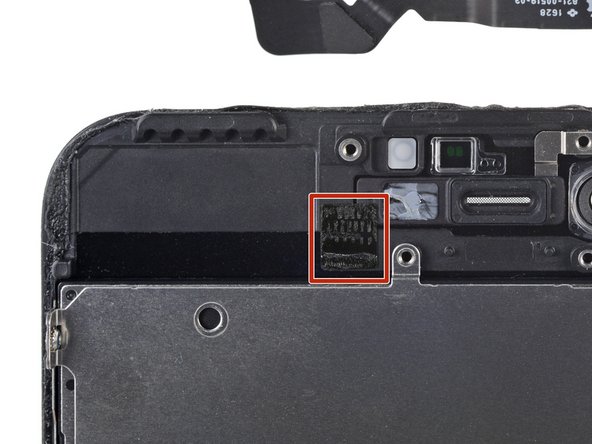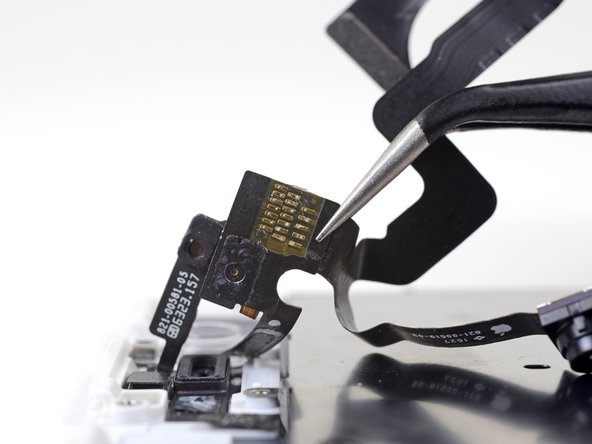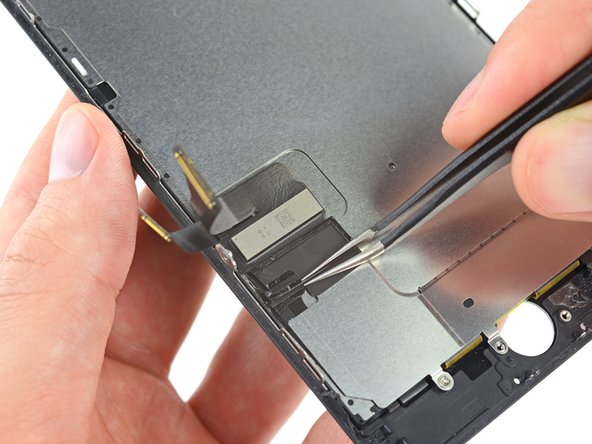Esta versão pode conter edições incorretas. Mude para o último instantâneo verificado.
O que você precisa
-
Este passo não foi traduzido. Ajude a traduzi-lo
-
Power off your iPhone before beginning disassembly.
-
Remove the two 3.4 mm pentalobe screws at the bottom edge of the iPhone.
-
-
-
Meça 3 mm a partir da ponta e marque a palheta com um marcador permanente.
-
-
Este passo não foi traduzido. Ajude a traduzi-lo
-
If your display glass is cracked, keep further breakage contained and prevent bodily harm during your repair by taping over the glass.
-
Lay overlapping strips of clear packing tape over the iPhone's display until the whole face is covered.
-
If the broken glass makes it difficult to get a suction cup to stick in the next few steps, try folding a strong piece of tape (such as duct tape) into a handle and lifting the display with that instead.
-
-
-
Puxe a pega azul para trás para destravar os braços do Anti-Clamp.
-
Deslize os braços pela borda esquerda ou direita do seu iPhone.
-
Posicione as ventosas próximo à borda inferior do iPhone, diretamente acima do botão home - uma pela dianteira e a outra pela traseira.
-
Aperte as ventosas uma contra a outra para aplicar sucção na área desejada.
-
-
-
Puxe a pega azul para a frente para travar os braços.
-
Gire a pega 360 graus no sentido horário até que as ventosas comecem a se esticar.
-
Certifique-se de que as ventosas permaneçam alinhadas uma com a outra. Se elas começarem a ficar desalinhadas, solte um pouco as ventosas e realinhe os braços.
-
-
-
Aqueça uma bolsa térmica iOpener e passe-a pelos braços do Anti-Clamp.
-
Dobre a bolsa térmica iOpener de modo que ela fique sobre a borda inferior do iPhone.
-
Aguarde um minuto para que o adesivo tenha a chance de se soltar e apresentar um vão para a abertura.
-
Insira uma palheta de abertura no vão.
-
Pule as próximas três etapas.
-
-
-
O aquecimento da borda inferior do iPhone ajudará a amolecer o adesivo que prende a tela, facilitando a abertura.
-
Use um secador de cabelo ou prepare uma bolsa térmica iOpener e aplique-o(a) na borda inferior do iPhone por cerca de 90 segundos para amolecer o adesivo que se encontra por baixo.
-
-
-
Aplique uma ventosa de sucção na metade inferior do painel dianteiro, imediatamente acima do botão home.
-
-
-
Este passo não foi traduzido. Ajude a traduzi-lo
-
Remove the following four tri-point Y000 screws securing the lower display cable bracket to the logic board:
-
Three 1.2 mm screws
-
One 2.6 mm screw
-
-
Este passo não foi traduzido. Ajude a traduzi-lo
-
Use the point of a spudger to lift the battery connector out of its socket on the logic board.
-
-
Este passo não foi traduzido. Ajude a traduzi-lo
-
Use the flat end of a spudger or a fingernail to disconnect the two lower display connectors by prying them straight up from their sockets on the logic board.
-
-
Este passo não foi traduzido. Ajude a traduzi-lo
-
Remove the three tri-point Y000 screws securing the bracket over the front panel sensor assembly connector:
-
One 1.3 mm screw
-
Two 1.0 mm screws
-
Remove the bracket.
-
-
Este passo não foi traduzido. Ajude a traduzi-lo
-
Disconnect the front panel sensor assembly connector from its socket on the logic board.
-
-
Este passo não foi traduzido. Ajude a traduzi-lo
-
Remove the five Phillips screws securing the earpiece speaker bracket:
-
Two 1.8 mm screws
-
One 2.3 mm screw
-
One 2.4 mm screw
-
One 2.8 mm screw
-
-
Este passo não foi traduzido. Ajude a traduzi-lo
-
Use the flat end of a spudger to lift the front-facing camera from its housing.
-
Gently bend the camera ribbon cable to the side to clear the way to the earpiece speaker underneath.
-
-
Este passo não foi traduzido. Ajude a traduzi-lo
-
Gently fold the camera and attached ribbon cable toward the bottom of the iPhone to allow access to the components underneath.
-
-
Este passo não foi traduzido. Ajude a traduzi-lo
-
Slide a spudger under the ambient light sensor flex cable, and lift the sensor out of its housing.
-
-
Este passo não foi traduzido. Ajude a traduzi-lo
-
Slide the tip of a spudger underneath the proximity sensor flex cable, and lift the sensor out of its housing.
-
-
Este passo não foi traduzido. Ajude a traduzi-lo
-
Insert the sharp edge of an iFixit opening tool underneath the camera assembly's flex cable, on the opposite side from the front-facing camera.
-
Pry up to separate the edge of the flex cable from the back of the display.
-
-
Este passo não foi traduzido. Ajude a traduzi-lo
-
Insert the point of a spudger underneath the same portion of the flex cable that you separated in the previous step.
-
Continue separating the remainder of the flex cable, pushing the spudger toward the row of circular gold earpiece speaker contacts.
-
-
Este passo não foi traduzido. Ajude a traduzi-lo
-
Continue using your spudger to carefully separate the last of the flex cable from the back of the display.
-
-
Este passo não foi traduzido. Ajude a traduzi-lo
-
Remove the front camera and sensor cable assembly.
-
A piece of black double-sided insulating tape lies between the display and three rows of copper contacts on the back of the camera/sensor cable. It may remain stuck to the display, or it may come off with the cable.
-
-
Este passo não foi traduzido. Ajude a traduzi-lo
-
Remove the four Y000 screws securing the bracket over the home/Touch ID sensor:
-
One 1.1 mm screw
-
Three 1.3 mm screws
-
-
Este passo não foi traduzido. Ajude a traduzi-lo
-
Remove the bracket that secures the home/Touch ID sensor.
-
-
Este passo não foi traduzido. Ajude a traduzi-lo
-
Pry under the left edge of the home button cable connector to disconnect it from its socket.
-
-
Este passo não foi traduzido. Ajude a traduzi-lo
-
Carefully pry up the underlying connector and move it out of the way of the home/Touch ID cable.
-
If the connector doesn't pry up easily, use a hair dryer or iOpener to heat and soften the adhesive securing the connector, and then try again.
-
-
Este passo não foi traduzido. Ajude a traduzi-lo
-
Flip the display assembly over. Use a hairdryer or prepare an iOpener and apply it to the lower edge of the display for about 90 seconds in order to soften up the adhesive underneath.
-
-
Este passo não foi traduzido. Ajude a traduzi-lo
-
Use an opening pick to gently separate the adhesive holding the home/Touch ID sensor cable to the back side of the display panel.
-
-
Este passo não foi traduzido. Ajude a traduzi-lo
-
Remove the home/Touch ID sensor assembly by lifting it through the front side of the display.
-
-
Este passo não foi traduzido. Ajude a traduzi-lo
-
Peel back the upper, rectangular portion of the LCD shield plate sticker to separate it from the flex cable underneath.
-
-
Este passo não foi traduzido. Ajude a traduzi-lo
-
Use a Y000 driver to remove three 1.1 mm screws from one side of the display EMI shield.
-
-
Este passo não foi traduzido. Ajude a traduzi-lo
-
Use a Y000 driver to remove two more 1.1 mm screws from the other side of the EMI shield.
-
-
Este passo não foi traduzido. Ajude a traduzi-lo
-
Remove the 1.8 mm Phillips screw securing the EMI shield near the bottom of the display.
-
-
Este passo não foi traduzido. Ajude a traduzi-lo
-
Lift the LCD shield plate while pressing down on the flex cable it surrounds.
-
Feed the flex cable through the cutout in the LCD shield plate, being careful not to snag it.
-
Cancelar: não concluí este guia.
193 outras pessoas executaram este guia.
18 comentários
Step 14 Pic# 3 the second cable damaged , what can i do ?!
If you damaged only the cable and nothing else, replacing the display should solve the problem—it will come with new cables attached.
Has anyone else had trouble getting the Y000 screws out from the bracket over the home/Touch ID sensor? All other Y000 came out no problem. These are fighting me. The driver seems to be spinning in place as if too big. Follow up question. If I strip these screws, any idea how to get them out then?
In my situation the Y screw behind the Home/Fingerprint Button seems to be GLUED ON by design to prevent inexperienced non-certified Apple replacers to remove it. So what I did was left it on to prevent stripping the screw and breaking the button. I just CAREFULLY BENT the metal bracket AT AN ANGLE so that I can maneuver the whole assembly into the hole of the screen and remove it.
